To captivate your audience effectively, tailor your content, tell powerful stories, and use interactive strategies as top public speakers do. Understand your audience demographics and segment them to address their specific needs. Craft stories with clear turning points and end with a compelling vision for impact. Engage your crowd with polls, Q&A sessions, and interactive tools. Create a distraction-free environment and optimize lighting for virtual events. Structure your presentations like stories with engaging openings and a solid structure. Master these engagement tactics to establish a lasting connection with your audience.
Key Takeaways
- Incorporate interactive elements like polls and Q&A sessions.
- Utilize storytelling techniques with clear turning points.
- End with a powerful vision to inspire and leave an impact.
- Create a distraction-free environment with optimal lighting.
- Encourage active participation through engaging tools and activities.
Audience Understanding and Segmentation
To engage your audience effectively, understanding and segmenting them based on demographics, job titles, and interests is essential. By segmenting your audience, you can tailor your presentations to address specific groups' needs and concerns, enhancing audience engagement.
Knowing why your audience is present allows you to customize your content effectively, increasing relevance and interest. Additionally, adjusting your presentation style and content to match the audience's preferences and biases helps establish a better connection and impact.
Incorporating data and examples that resonate with the audience's experiences further increases relevance and relatability, making your message more memorable and compelling. By understanding your audience's demographics, job titles, and interests, you can create presentations that captivate and resonate with them, leading to higher levels of engagement and interaction during your speeches.
Storytelling Techniques for Engagement

Incorporating a call to adventure in your presentation captures audience attention and sets the stage for engagement. Storytelling techniques play a pivotal role in keeping your audience captivated throughout your talk. Utilize contrasting elements in your stories to maintain interest and create dynamic narratives that resonate with your audience.
Structure your presentation like a story with clear turning points to keep listeners engaged and invested in your message.
Moreover, ending your presentation with a vision of what could be serves to inspire your audience and leave a lasting impact. By tailoring your storytelling to address the specific needs, concerns, and interests of your audience, you can guarantee maximum engagement and connection.
Interactive Audience Engagement Strategies

Top public speakers enhance audience engagement by utilizing interactive elements such as polls, Q&A sessions, and live chat. These strategies create a dynamic environment where audience members feel involved and connected to the presentation.
Interactive storytelling techniques and audience participation further boost engagement levels by making the audience an active part of the presentation. Real-time feedback allows speakers to adjust their content based on audience responses, keeping the presentation relevant and engaging.
Additionally, incorporating audience response systems, virtual whiteboards, and breakout rooms fosters a more interactive experience for attendees. By utilizing gamification, quizzes, and interactive activities, public speakers can keep the audience actively participating and interested throughout the presentation.
These interactive strategies not only encourage participation but also create a two-way dialogue between the speaker and the audience, making the presentation more memorable and impactful. Effective use of interactive tools is key to engaging your audience and creating a successful speaking experience.
Virtual Event Speaker Engagement Tips

For effective involvement during virtual events, incorporate interactive elements to enthrall attendees. Timing, storytelling, and audience cues are pivotal in capturing and maintaining audience engagement. Encouraging active participation through polls, Q&A sessions, and interactive tools is vital for virtual events.
Guarantee attention to detail by creating a distraction-free environment and optimizing lighting to enhance audience engagement further. Utilizing social media, themed events, and virtual event swag bags can boost attendee interaction and create a memorable experience.
To engage your virtual event audience effectively, consider implementing engagement strategies such as interactive polls to gather real-time feedback, Q&A sessions to address audience inquiries, and interactive tools to encourage participation. Additionally, maintaining a captivating storytelling approach and being mindful of audience cues can help sustain interest throughout the event.
Effective Presentation Structure

Plan your presentation structure with a clear start, middle, and end to effectively engage your audience. By framing your presentation as a story with a call to adventure, you can capture the audience's attention right from the beginning. Integrate contrasting elements throughout your presentation to secure audience engagement remains high. End your presentation with a powerful vision of what could be, inspiring your audience towards action or reflection. Structuring your presentation similar to a story, complete with distinct turning points, will create a cohesive and engaging narrative flow that keeps your audience captivated.
| Key Elements | Description |
|---|---|
| Clear Start | Introduce the topic and set the stage for the presentation. |
| Compelling Middle | Develop the main points with engaging content and visuals. |
| Impactful End | Conclude with a strong call to action or reflection to leave a lasting impression. |
Tailoring Content to Audience Needs

To effectively engage your audience, tailor your presentation content to meet their specific needs and preferences based on demographics, job titles, and interests.
Segmenting your audience allows you to understand their expectations and reasons for attending your presentation. Utilize data and examples that resonate with the experiences and interests of your audience members.
By adjusting your presentation style and content to address their needs, concerns, and biases, you can create a more impactful delivery. Engage your audience by incorporating elements that reflect their preferences, ensuring a personalized and enthralling experience.
Engaging Opening Strategies

Capture your audience's attention right away by starting your presentation with a surprising fact. Engaging opening strategies play a crucial role in setting the tone for your presentation and drawing in your audience right from the beginning. Begin by revealing a compelling statistic or piece of information that immediately captivates your listeners. This unexpected turn will spark their interest and create a sense of intrigue, making them excited to hear more.
Moreover, consider using a relevant story at the beginning to establish an emotional connection with your audience. Sharing a personal anecdote or experience can humanize your presentation and make it more relatable, helping you forge a deeper bond with your listeners.
Additionally, posing a thought-provoking question can stimulate curiosity and engagement right from the start, encouraging active participation and interaction.
Impactful Audience Connection

Start your presentation by establishing a strong connection with your audience through relevant pop-culture references like Mindy Kaling, fostering relatability and enhancing engagement from the outset.
By grabbing your audience's attention with familiar cultural touchpoints, you set the stage for a more receptive audience.
Sharing your real-world successes, such as writing for prominent publishers, not only builds credibility but also reinforces key communication principles. In addition, discussing personal failures and rejections can inspire resilience in your audience, imparting valuable lessons in persistence and growth.
To truly connect with your audience, apply lessons learned from both successes and setbacks to drive home communication principles effectively. Encouraging audience interaction through storytelling, authenticity, and shared experiences creates a supportive environment for forging meaningful connections during your presentation.
Frequently Asked Questions
How Do Effective Public Speakers Captivate and Engage Their Audience?
You captivate your audience by incorporating pop-culture references and sharing real-world successes. Connect through discussing failures and challenges, driving home communication principles. Foster engagement by creating a supportive environment and inspiring connections with authenticity and shared experiences.
What Are the 5 Steps to Captivate the Attention of the Audience?
To captivate the attention of the audience, grab their interest with a powerful opening, maintain engagement with contrasting elements, structure your presentation like a story, tailor it to their needs, and use humor and storytelling to connect.
What Techniques Does the Speaker Use to Engage the Audience?
To engage the audience effectively, the speaker employs pop-culture references, real-world success stories, and openly discusses failures. By being relatable, human, and authentic, they encourage engagement through storytelling, entertainment, and shared experiences.
What Is the Best Way to Keep Your Audience Engaged?
To keep your audience engaged, use humor, storytelling, and audience interaction. Dress slightly above them for credibility. Move purposefully on stage to hold attention. Connect early and avoid distracting movements. These tactics maintain interest and connection.
What Engagement Tactics Do Top Public Speakers Use to Captivate Their Audience?
When it comes to becoming a great public speaker, top speakers rely on a variety of engagement tactics to captivate their audience. This includes using storytelling, humor, audience interaction, and vocal variety. They also make sure to research their audience and tailor their message to resonate with them on a personal level.
Conclusion
To wrap up, enthralling your audience is all about grasping their needs, narrating compelling stories, and maintaining their involvement through interactive strategies.
Remember, the key to success is to customize your content to suit their preferences and establish a personal connection with them.
So, don't hesitate to innovate and make your presentations distinguishable. After all, the proactive individual reaps the rewards!










